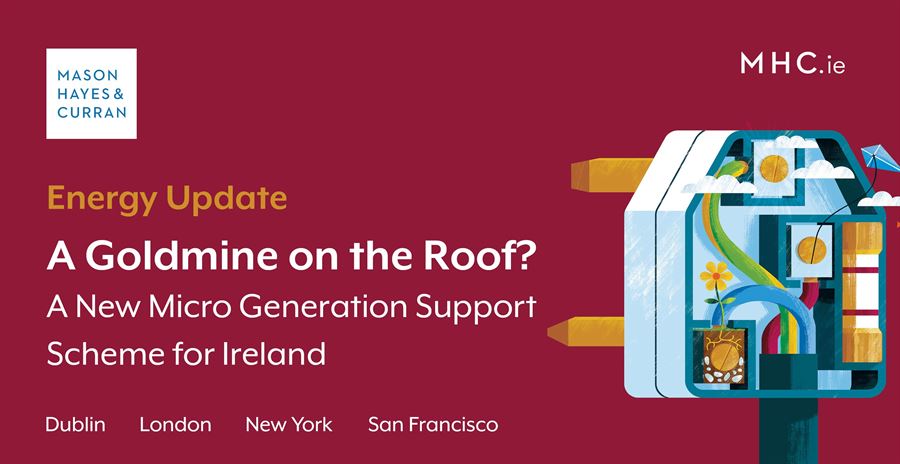
What is micro-generation?
Micro-generation is described in the consultation paper as the generation of renewable electricity on a small scale with a maximum electrical output of 50kW. It is primarily designed to service the needs of the property or community where it is installed.
Ireland has set itself ambitious energy decarbonisation targets. The facilitation of micro-generation reflects a view that switching energy generation to distributed, renewable sources is a credible method by which this can be achieved.
The Irish government’s Climate Action Plan includes the following goals for the electricity sector:
-
Put in place a coherent support scheme for micro-generation with a price for selling power to the grid
-
Open up opportunity for community participation in renewable generation, as well as community gain arrangements
-
Streamline the consent system, the connection arrangements, and the funding supports for new technologies
In order to develop a detailed understanding of inputs and best practice for micro-generation in Ireland, the Department of the Environment, Climate and Communications (DECC) commissioned an economic and policy analysis report,. The report indicates how Ireland can most cost effectively provide a framework that will comply with its requirements of the recast Renewable Energy Directive 2018 (RED II) and also contribute to achieving our objectives under the Climate Action Plan and the 2020 Programme for Government. The evidence base of this analysis report has been used to inform the proposed high-level design for the micro-generation scheme, which is now the subject of the current consultation exercise.
What is the proposed scheme and how will it work?
There are various options for incentivising and/or funding micro-generation in Ireland. These include:
-
Suppliers recovering the costs based on their market value
-
Suppliers recovering the costs through a Public Sector Obligation (PSO) levy
-
Suppliers socialising the costs through their unit rates, and
-
The Exchequer funding the costs via a voted grant scheme
The proposed structure for the high-level design of the scheme includes:
-
Implementation of a proposed Clean Export Guarantee (CEG) tariff for excess electricity exported to the grid that reflects “fair market value”. Initially the CEG is proposed to be a fixed, minimum tariff provided by suppliers on a pass-through basis. It will be based on the annual average Day Ahead Market wholesale electricity price.
-
Additional supports for new micro-generation technologies installed after 30 June 2020. This will be done through a fixed Clean Export Premium (CEP) tariff rate each for domestic and non-domestic consumers for the excess electricity export to the grid. The support will be provided for a period of 15 years and will be subject to a cap of 30% of total generation. It is suggested that the CEP will only be available to existing buildings.
-
Eligibility criteria will be in place. It is currently proposed at a maximum capacity of 50kWe for wind, hydro and solar energy and a maximum capacity of 30kWe for CHP energy (Combined Heat and Power, which excludes non-renewable fuels). In addition, a “community” will have to meet the definition of community set out in article 2(16) of the RED II Directive.
-
The funding proposal is that suppliers may recover the costs of the premium support through the PSO levy.
The scheme is intended to be part of a regulated annual review process, which would provide clarity and transparency around spending and funding. It is also expected that micro-generators will, in practice, receive the equivalent to “priority dispatch”, as there will be no requirement to submit to dispatch instructions in relation to when excess electricity is exported to the grid. DECC is asking stakeholders whether they agree to each element of the proposal or, in the case that they disagree, to propose an alternative model for consideration.
There will still be a number of barriers that may impact on any assessment of options for a suitable support scheme for micro-generation. These include:
-
Planning
-
Grid connections for export
-
Access to and cost of finance and systems to measure and settle exported electricity
Who will it benefit?
Aside from the broader policy benefits of increasing the amount of renewable electricity used nationwide, this scheme provides an interesting opportunity for individual homeowners and communities to enter the electricity market on a manageable scale. It will also allow them to enter hopefully on a cost-effective basis, after first producing energy that satisfies their own requirements. Builders and developers should also consider the merits of this proposal in detail, as they may have valuable perspectives on how these schemes can be deployed on a broader scale.
Conclusion
The proposed micro-generation policy has the potential to assist Ireland’s achievement of its emissions targets and upholds the concept of community empowerment as emphasised in the Climate Action Plan. However, this consultation deals only with the high-level design of the scheme. A detailed assessment of the structures required both in terms of administering and managing the scheme reviews will be undertaken separately.
If you wish to discuss this proposed scheme, please contact a member of our Energy team.
The content of this article is provided for information purposes only and does not constitute legal or other advice.



